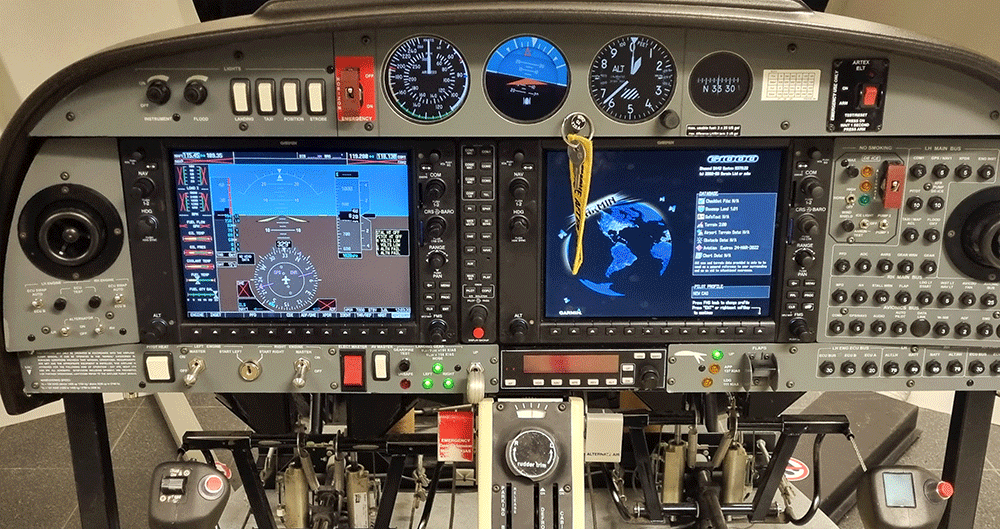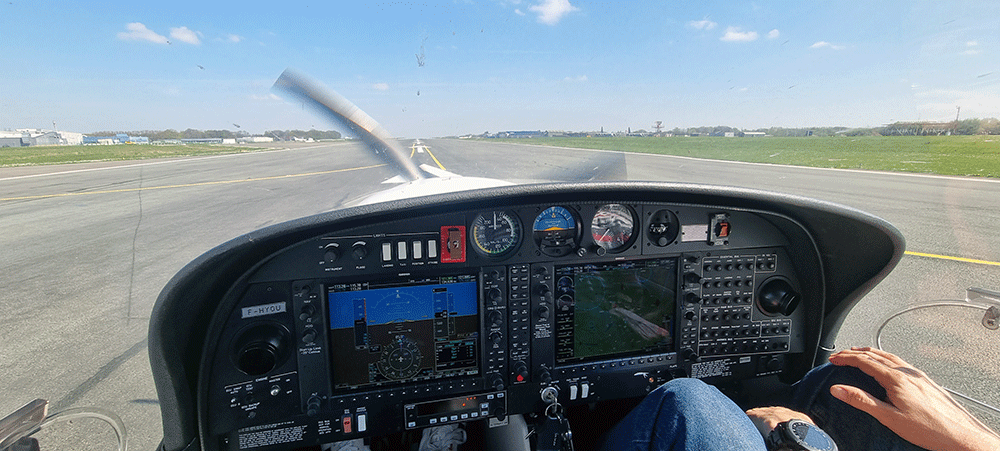My local club has two Da-20 and two PA-28 and we fly out of an uncontrolled airstrip. It’s great flying but I want new challenges in my amateur pilot career. I love to fly the Da-20 but when I need to take more than one passenger I need to fly the PA-28s and I don’t feel confident in the airplane as they are completely different to handle than the sporty Diamonds.
I always wanted to fly the Da-40 (the Da-42 and the Da-62 as well, but that’s way outside my league for now) The Da-40 fulfils my mission taking the family of four for a Sunday trip. Furthermore one of my long term goal is IFR and a not so distant goal being night rating I need to find a school to first get checked in the Da-40.
Another shortcoming I want to address as a private pilot is my lack of experience with controlled airspace and ATC communications. Flying out of EBGB I confess I hardly go into controlled airspace. I pickup uncontrolled airfield to land at and I mostly stays in Class G airspace talking only to Flight information service and local AFIS.
It is a shortcoming I identified a long while ago but addressing it is not so easy. Indeed flying through controlled airspace is not difficult but the experience gained is not very different than talking to the FIC. To get valuable experience IMHO you need to land at controlled airports and in Belgium those are quite expensive. Not only the landing fees are higher, but most of the time handling is mandatory and adds to the costs.
Although EBOS and EBAW are not so expensive, landing at EBCI or EBBR as non based is a big no no.
On the other hand when you train at a local school in a major airport, you benefit from the arrangement that school may have with the airport authorities and most of the time, the landing fees are included in your hourly rates and there is no mandatory handling since you are trained using the local facilities. (No automatic follow me truck when you come in for landing 🙂
It’s time for me to get outside my comfort zone 🙂

Charleroi Brussels South (EBCI) was my logical choice. It’s the hub of Ryan Air in Belgium. it’s a decent sized airport with medium commercial traffic and there are a few flying schools on the premises.
I selected New CAG as my next ATO (Approved Training Organisation). They have a fleet of Sonaca-200, Diamond Da-40 & DA-42.
One of the Da-40 has a G-1000 and if you’re checked out on the G-1000 you can fly the whole fleet of Da-40. Even if that implies by starting with a simulator session to learn the G-1000 avionic suite, it’s better than being restricted to “analogues” Da-40s.
The admin team by New CAG is super friendly and helped me on all prior admin tasks like getting the paperwork ready, selecting an instructor, getting setup with their planning online tool and their online learning system and getting the airport badge.
Airport access is restricted and pilots need to get a badge to enter the premises. Although the general aviation ramp is on the South part separated from the commercial ramp on the North part of the airfield, badges applicants all have to go through the same e-learning class and have to pass a small security test.
The simulator:

My G1000 avionic suite training was scheduled on the school’s ATD (Approved Training Device) a Sunday Morning in March 2022. The sim is a Da-42 but can be logged as a Single engine piston as well simulating the DA-40.

Being a flight simmer and cockpit builder I appreciated the professional hardware, the semi circular screen and more specifically the instructor station allowing the student to be tested in many abnormal situations.

I was looking forward to the G-1000 suite presentation from a professional instructor and I had a great time learning features I wasn’t aware of as well as some obvious tricks I completely missed on my own simulator: One of them strike me as being so obvious after I was told: Rather than cross your arms and using the left side knobs on the PFD, use the left side knobs on the MFD, they have the same functions are are way more accessible.
I felt like an idiot !!
First Da-40 flight:
A few weeks later I was finally seating in the pilot seat of the Da-40.
The Da-40 is very similar to the Da-20. There is no mixture to manage as the FADEC does everything automatically. Engine start is also much easier as the Da-20 is a real pain to start warm due to vapor lock. The Da-40 ECU management is very transparent but was studied in depth before the flight.
One caveat of the G-1000 equipped Da-40 is that the electrical power output is not able to power the full G1000 at engine start-up. So we are taught to pull the MFD breaker to decrease consumption during engine start. But regardless very often the G-1000 resets completely at engine start (even with only the PFD powered up) which prevents pilots to check oil pressure directly after start. Luckily the G-1000 reboots quickly and everything comes back to normal.
Taxiing the Da-40 is the same as the Da-20. the free castering nose wheel is a problem for many pilots unaware of that feature but I was used to it already. (it is not linked to the rudder)

What I was not used to was the intensity of the radio communications. The switch from EBGB to EBCI was quite a change. It was expected but you can be overloaded just with listening to the radio.
The first flight was general flying and we went south of the CTR so I could get a feeling of the airplane before we performed the usual manoeuvre’s like stalls, turns, unusual attitude recoveries. And we then came back for landing.
Second flight:
The next part of the check-out was without surprise touch and goes. And touch and goes on a busy day at EBCI can quickly turn into making a lot of 360° on downwind or being sent back away from the pattern because traffic is too heavy.
But we managed enough touch and goes to perform the usual requirements.
The engine failure exercise really made me realise how long the runway is.
The instructor briefed me that after the next touch, on the climb out he would cut the engine and let me perform a dead stick landing on the remaining runway.
Sure enough at a certain altitude he cut the throttle and declared engine out. I immediately pushed the stick forward to attain best glide speed. The sight picture was quite impressive with the runway filling the windscreen up to the flare. Once rolling on the ground we set the flaps and applied full power for take-off again.
Coming from a 600m grass strip where I usually trained engine out landing it was quite an experience!
At the end of the flight I was checked out on the Da-40 but I didn’t feel confident I was able to manage the ATC on my own, so I requested an extra flight with my instructor to get a bit more experience managing the radio.
Conclusions:
Flying the Da-40 was not a problem coming from the Da-20. The handling of the aircraft is very similar.
Managing the G-1000 requires focus but my needs are rather limited as I don’t (yet) need to manage complicated IFR approaches. For VFR navigation the G-1000 is overkill but that is the type of avionics I want to use in flight and there are so many things to learn in the process.

The biggest challenge for me was clearly the ATC. I wanted this with a purpose in mind and it was very productive thanks to the kindness and professionalism of my instructor and the EBCI ATC team.
I have now much more confidence in my abilities to fly and land in controlled airspace which I feel was one of the shortcoming of my initial training.
I have now the rest of the summer to build a few hours flying the Da-40 before I do my night VFR at EBCI with New CAG this coming winter.
